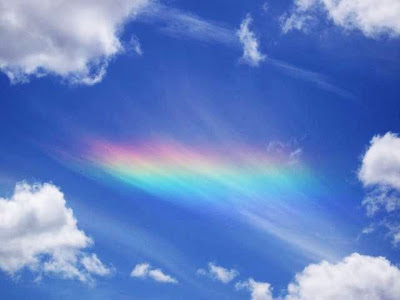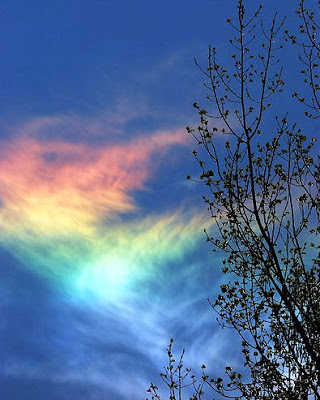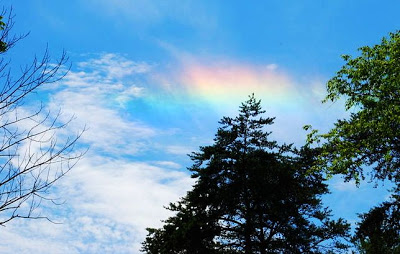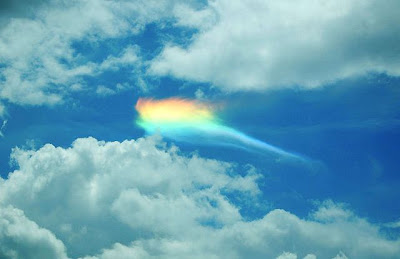Philosophy

Wikipedia...
A circumhorizontal arc is an optical phenomenon - an ice-halo formed by plate-shaped ice crystals in high level cirrus clouds.
Other currently accepted names for the phenomenon are circumhorizon arc or lower symmetric 46° plate arc. The misleading term "fire rainbow" is sometimes used to describe these phenomena, although they are neither rainbows, nor related in any way to fire.
The complete halo is a huge, multi-coloured band running parallel to the horizon with its centre beneath the sun. The distance below the sun is twice as far as the common 22-degree halo. Red is the uppermost colour. Often, when the halo-forming cloud is small or patchy, only fragments of the arc are seen.
How often a circumhorizontal arc is seen, depends on the location and the latitude of the observer. In the United States it is a relatively common halo seen several times each summer in any one place. In contrast, it is rare phenomenon in northern Europe for several reasons.
Formation of the halo requires that the sun be very high in the sky, at an elevation of 58° or greater, and that a cirrus cloud or haze be present and contain plate-shaped ice crystals. The sun's altitude determines the visibility of the halo; it is impossible to see at locations north of 55°N or south of 55°S (although a lunar circumhorizon arc might be visible at other latitudes). At other latitudes the phenomenon is visible, for a greater or lesser time, around the summer solstice. Slots of visibility for different latitudes and locations may be looked up here. For example, in London, England the sun is only high enough for 140 hours between mid-May and late July. Contrast that with Los Angeles, with the sun higher than 58 degrees for 670 hours between late March and late September.
The halo is formed by sunlight entering horizontally-oriented, flat, hexagon ice crystals through a vertical side face and leaving through the near horizontal bottom face (plate thickness does not affect the formation of the halo). In principle, Parry oriented column crystals may also produce the arc, although this is rare. The 90° inclination between the ray entrance and exit faces produce the well-separated spectral colours.
The arc has a considerable angular extent and thus, rarely is complete. When only fragments of a cirrus cloud are in the appropriate sky and sun position, they may appear to shine with spectral colours.
A circumhorizontal arc may be difficult to distinguish from an infralateral arc when the sun is high in the sky. The former is always parallel to the horizon, whereas the latter curves upward at its ends.




- What Do You Do With The Plate?: Why I Am Glad To Be Married, Edition 316
The other day I was reminded of a story told to me by a dear friend back when we were both single. He had broken up with a woman he had been dating for a while and they had done the picking up all your stuff from the other person's apartment and a...
- Hunter's Moon Will Diminish Most Of The Orionid Meteor Shower
"Hunter’s Moon to wash out 2013 Orionid meteor shower" Earth & Sky The October full moon – the Northern Hemisphere’s Hunter’s Moon – is (or was if you’re reading this later) on the night of October 18-19, 2013. In a bit of misfortune...
- Google Doodle For Robert Noyce
"Robert Noyce, superstar of Silicon Valley, gets a Google Doodle" December 12th, 2011 Los Angeles Times Robert Noyce -- called a modern-day Thomas Edison in his 1990 obituary in the Los Angeles Times -- was smart, yes. The co-inventor of the microchip...
- That Time Of Year..."snowflake" Talk
We had our first snowfall early in the dark this morning...just a trace. So now we take up snowflakes again. "Snowflake science" December 6th, 2011 R&D We've all heard that no two snowflakes are alike. California Institute of Technology (Caltech)...
- Amazing .gifs Of Super Hero Comic Books
"Iron Man Gets the Shakes and Other Superheroic Animated GIFs" by Lewis Wallace December 1st, 2011 Wired Lovingly crafted by comics creator Kerry Callen, the image is one of four he made to test his hand at injecting movement into iconic superhero...
Philosophy
Circumhorizontal arc [aka Fire Rainbows]
Wikipedia...
A circumhorizontal arc is an optical phenomenon - an ice-halo formed by plate-shaped ice crystals in high level cirrus clouds.
Other currently accepted names for the phenomenon are circumhorizon arc or lower symmetric 46° plate arc. The misleading term "fire rainbow" is sometimes used to describe these phenomena, although they are neither rainbows, nor related in any way to fire.
The complete halo is a huge, multi-coloured band running parallel to the horizon with its centre beneath the sun. The distance below the sun is twice as far as the common 22-degree halo. Red is the uppermost colour. Often, when the halo-forming cloud is small or patchy, only fragments of the arc are seen.
How often a circumhorizontal arc is seen, depends on the location and the latitude of the observer. In the United States it is a relatively common halo seen several times each summer in any one place. In contrast, it is rare phenomenon in northern Europe for several reasons.
Formation of the halo requires that the sun be very high in the sky, at an elevation of 58° or greater, and that a cirrus cloud or haze be present and contain plate-shaped ice crystals. The sun's altitude determines the visibility of the halo; it is impossible to see at locations north of 55°N or south of 55°S (although a lunar circumhorizon arc might be visible at other latitudes). At other latitudes the phenomenon is visible, for a greater or lesser time, around the summer solstice. Slots of visibility for different latitudes and locations may be looked up here. For example, in London, England the sun is only high enough for 140 hours between mid-May and late July. Contrast that with Los Angeles, with the sun higher than 58 degrees for 670 hours between late March and late September.
The halo is formed by sunlight entering horizontally-oriented, flat, hexagon ice crystals through a vertical side face and leaving through the near horizontal bottom face (plate thickness does not affect the formation of the halo). In principle, Parry oriented column crystals may also produce the arc, although this is rare. The 90° inclination between the ray entrance and exit faces produce the well-separated spectral colours.
The arc has a considerable angular extent and thus, rarely is complete. When only fragments of a cirrus cloud are in the appropriate sky and sun position, they may appear to shine with spectral colours.
A circumhorizontal arc may be difficult to distinguish from an infralateral arc when the sun is high in the sky. The former is always parallel to the horizon, whereas the latter curves upward at its ends.




Strange clouds
- What Do You Do With The Plate?: Why I Am Glad To Be Married, Edition 316
The other day I was reminded of a story told to me by a dear friend back when we were both single. He had broken up with a woman he had been dating for a while and they had done the picking up all your stuff from the other person's apartment and a...
- Hunter's Moon Will Diminish Most Of The Orionid Meteor Shower
"Hunter’s Moon to wash out 2013 Orionid meteor shower" Earth & Sky The October full moon – the Northern Hemisphere’s Hunter’s Moon – is (or was if you’re reading this later) on the night of October 18-19, 2013. In a bit of misfortune...
- Google Doodle For Robert Noyce
"Robert Noyce, superstar of Silicon Valley, gets a Google Doodle" December 12th, 2011 Los Angeles Times Robert Noyce -- called a modern-day Thomas Edison in his 1990 obituary in the Los Angeles Times -- was smart, yes. The co-inventor of the microchip...
- That Time Of Year..."snowflake" Talk
We had our first snowfall early in the dark this morning...just a trace. So now we take up snowflakes again. "Snowflake science" December 6th, 2011 R&D We've all heard that no two snowflakes are alike. California Institute of Technology (Caltech)...
- Amazing .gifs Of Super Hero Comic Books
"Iron Man Gets the Shakes and Other Superheroic Animated GIFs" by Lewis Wallace December 1st, 2011 Wired Lovingly crafted by comics creator Kerry Callen, the image is one of four he made to test his hand at injecting movement into iconic superhero...
